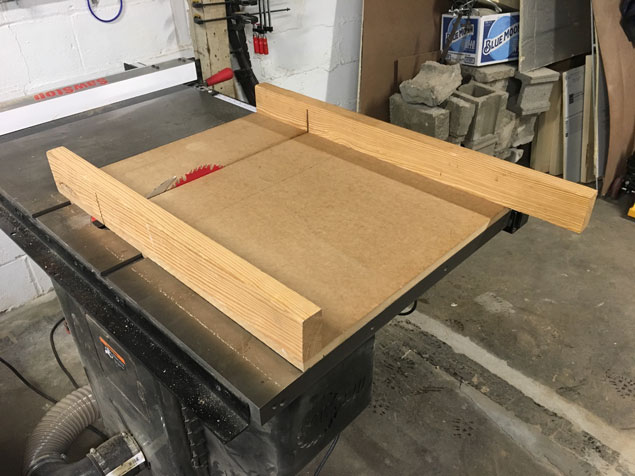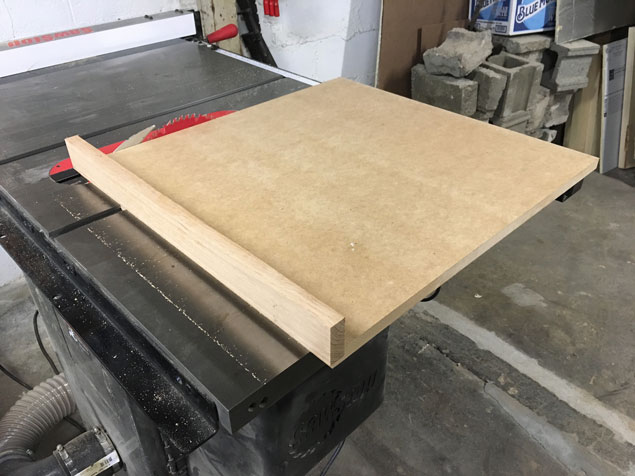We may receive a commission when you use our affiliate links. However, this does not impact our recommendations.
No, you have not entered an alternative dimension. Today – on this blog that focuses on handwork – we are going to talk about table saw sleds.
When I do production work – processing hundreds of board feet of lumber for a class, for example – the table saw is an important machine. Table saws are great for ripping, but they are kind of crappy for crosscutting.
Manufacturers have devised all sorts of sliding tables and miter-slot jigs. I have used pretty much all of them. I’ve owned at least six of them and tested about 20. They all lack. Here’s why: They are adjustable.
About 99.99 percent of your crosscutting work at a table saw is to square the ends of boards to 90°. Yet, sliding tables allow you to crosscut at almost any angle. That seems like a good thing. It ain’t. That’s because of Schwarz’s First Law of Machinery: If something can be adjusted, it will go out of adjustment.
Put another way: Once you remove the crosscut fence or move it, it’s likely out of adjustment and needs to be trued up. Even an error of a fraction of a degree can ruin the squareness of a 1” x 24” x 48” carcase side.
That’s why I use two homemade table saw sleds. They do one thing: cut at 90° and nothing more. There are no adjustments to make. Once they are at 90°, they stay at 90°. I put a sled on my saw, and it cuts at 90°. Always and forever. The sleds cost about $10 in material and 30 minutes of time to make. If they ever become inaccurate after a decade of use, I’ll pony up another $10 to make another.
I know that some of you are squirming and squealing: “But my MasterCut 2000 (TM) sliding table is always accurate.” Perhaps it is. But I’ve never seen one of those tables stay accurate in a production environment for very long. Yes, even the European sliding table saws I’ve used have problems.
Homemade sleds are the answer. In the next entry I’ll show you how I make mine from MDF and scraps of oak and yellow pine.
— Christopher Schwarz
Here are some supplies and tools we find essential in our everyday work around the shop. We may receive a commission from sales referred by our links; however, we have carefully selected these products for their usefulness and quality.











Made one years ago based on Kelly Mehler’s plan. Easily my most used jig. I use it to cut 14′ pieces and, thanks to the Lexan guard, 2″ pieces. I often say that if I’m not using it, I’m probably ripping.
Excellent. Been wanting a couple sleds(one large, one small) and have been looking for ideas. All I’ve seen so far look really complicated to make or expensive to buy. I’m a simple man looking for a simple solution.
I have two shop-made sleds. One adjustable, one not. I use the non-adjustable one 99.9% of the time. The adjustable one is spot on BUT it’s more than likely due to its lack of use. So I’m in agreement now BUT I would have argued with the Schwarz when I built it fifteen years ago. LOL
I’m actually really excited for this series of posts. Funnily enough as a hand tool woodworker, this has been an idea in my head for the past few weeks. I work in an awful door factory in central Utah, blasting through as many doors as I can every day. But when I have time to think the thoughts I sincerely care about, I think about my own small, primarily hand tool shop. I’m in my late twenties, and own a pretty questionable old Grizzly table saw (nothing against Grizzly, as an exish-machinist I’m actually quite pleased with them… it’s just a saw that I got for free and has seen some hard times before someone said “If you can get this out of here it’s yours”).
It’s a saw that I almost never fire up for so many reasons, but when I do, I kind of use it for the same reasons you address in this prelim article. So I look forward to more. Thanks Chris, and thanks for the publications you make available through LAP. It means a lot to mean in relative isolation out here in the wasteland of the mountain west.